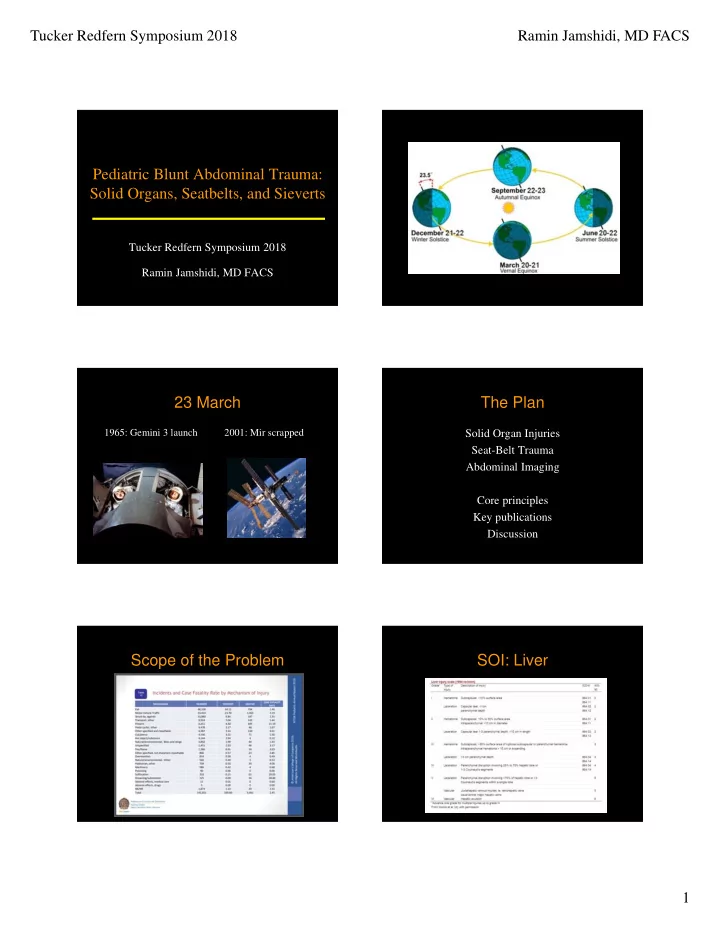

Tucker Redfern Symposium 2018 Ramin Jamshidi, MD FACS Pediatric Blunt Abdominal Trauma: Solid Organs, Seatbelts, and Sieverts Tucker Redfern Symposium 2018 Ramin Jamshidi, MD FACS 23 March The Plan 1965: Gemini 3 launch 2001: Mir scrapped Solid Organ Injuries Seat-Belt Trauma Abdominal Imaging Core principles Key publications Discussion Scope of the Problem SOI: Liver 1
Tucker Redfern Symposium 2018 Ramin Jamshidi, MD FACS SOI: Spleen AAST Grades of Injury SOI Management ATOMAC Guidelines APSA Guidelines (2000) Non-Op Failure SOI Post-Discharge • No/Transient response to 20mL/kg cryst + 20mL/kg PRBC • Restricted activity: grade + 2 weeks • Unstable of hgb < 7 after 40mL/kg PRBC • No routine follow-up imaging • Splenic blush not predictive • High-impact activities? 2
Tucker Redfern Symposium 2018 Ramin Jamshidi, MD FACS Solid Organ Injury • AAST standardized grading • Non-op management generally successful • Consider failure at 40mL/kg PRBC • Uncertainty in f/u imaging & rough activity Seat Belts Laws Seat Belt Sign Yes, Wear Them Seat Belts in MO • Mandatory seat belt laws • Fatalities reduced 8% • Serious injuries reduced 9% • Primary laws more effective than Secondary laws 3
Tucker Redfern Symposium 2018 Ramin Jamshidi, MD FACS Seat Belt Sign Belt Position “Seat Belt Syndrome” Abd wall bruising, intra-abd injury, spinal fracture (J Trauma 1962) SBS / Intra-Abd Injury • 585 pts w/ sbs: 14.4% IAI (6.8% to OR) • 5.2% IAI w/o sbs (1.5% op’n) • Of 249 IAI, 71% SOI, 25% GI, 6% panc 4
Tucker Redfern Symposium 2018 Ramin Jamshidi, MD FACS SBS / Intra-Abd Injury Identification of S/B Injuries • CT imaging important consideration • 120 pts, 38 w/ abnormal CT • Observation may be required despite CT • 13% HVI • 1/5 of HVI identified delayed • CT 3.6% false negative BAT Evaluation Options Seatbelt Syndrome • Seatbelts are good • Labs • Imaging • CT • Injuries are not rare • MRI • U/S • CT may be indicated • Observation • Diagnostic Laparoscopy • May need more than CT to exclude injury Radiation Measures • Grey (Gy) = 1 Joule / kg 1 Gy = 100 rads Physical quantity • 1 Sv = biological effect of 1 Gy absorbed 1 Sv = 100 rem Measure of effect 5
Tucker Redfern Symposium 2018 Ramin Jamshidi, MD FACS Radiation Radiation Exposure • Beta and gamma equivalent, alpha worse • 1 Gy alpha 20x worse than 1 Gy gamma • 1 Gy gamma = 1 Sv • 1 Gy alpha = 20 Sv Radiation Risk Background Radiation • US average: 3 mSv / year • Denver: 6 mSv / year • Flight crews: + 2.2 mSv / year Attributable Incidence Rads Risk prediction models from Japanese • Sensitivity: Lung > liver > muscle or skin atomic explosion survivors • Leukemia <= 10 years • Sum 50-60 mGy head: 3x brain tumor f • Sum 50-60 mGy marrow: 3x leukemia f • Exposure @ 50: 1/3 risk of 30 yo • 40yo woman coronary CTA: 1/270 • 40yo woman head CT: 1/8100 • 10 yo ~ 2 times risk of 30 yo • 29k future CA related to US CTs in 2007 • A/P 14k, C 4k, H 4k 6
Tucker Redfern Symposium 2018 Ramin Jamshidi, MD FACS Pediatric Sensitivity • Under age 10 ~ 3 times as sensitive • Effective doses 50% higher • Inherent sensitivity • Longer lifetime Pediatric Radiation Risk Exposure Reduction • Scan only when necessary • Adjust exposure for size • Reduce tube current • Increase pitch • Scan only areas of particular interest • Limit resolution (ALARA) BAT Evaluation Options Labs • Labs • Used as a ‘screening test’ to decide on CT • Imaging • CT • Unknown pathophysiology • MRI (AST/ALT with spleen) • U/S • Observation • Inconsistent threshold use • Diagnostic Laparoscopy 7
Tucker Redfern Symposium 2018 Ramin Jamshidi, MD FACS Labs: ROC for any IAI Ultrasound (FAST) 1.00 • Free fluid not specific 0.75 Sensitivity 0.50 0.25 • Free fluid not indication for operation 0.00 0.00 0.25 0.50 0.75 1.00 1-Specificity Area Under the Curve (AUC) • Weight/size-based variation in fluid ALT: 0.6731 AST: 0.6813 AMY: 0.5102 LIP: 0.6607 ALP: 0.4501 Reference Ultrasound (FAST) Choosing to Image • Helpful IF • Hemorrhage with hypotension • Refractory to transfusion • No other source of hemorrhage …might operate on basis of FAST • Abd pain • AST > 200 • Abd TTP, distension • Abnl Amy or Lip • Must maintain practice if considering use • Abnl CXR Choosing to Image Choosing to Image • Abd pain • AST > 200 • Abd TTP, distension • Abnl Amy or Lip • Abnl CXR 8
Tucker Redfern Symposium 2018 Ramin Jamshidi, MD FACS Choosing to Image Abd Trauma CT • FAST & labs have limitations • CT is ideal mode – use when necessary • Recognize rad risks & inform families • Consider observation / laparoscopy THANK YOU rjamshidi@phoenixchildrens.com rjamshidi@phoenixchildrens.com 9
Recommend
More recommend